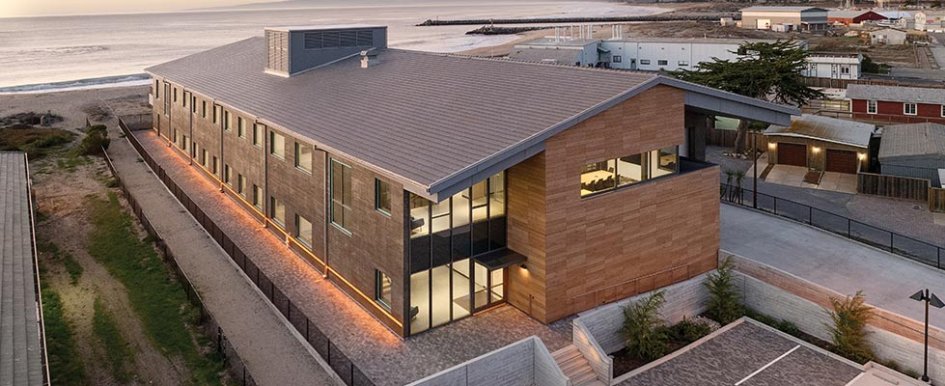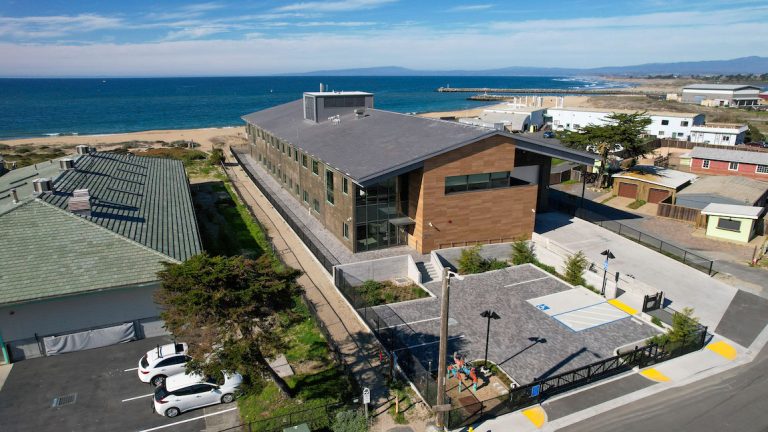
In 1977, David Packard and members of the Monterey, California, community had a vision: Create a world-class aquarium for residents of the city and beyond. In 1984, the Monterey Bay Aquarium opened its doors to the public. In 1987, Packard founded the Monterey Bay Aquarium Research Institute (MBARI) on the core principle of science, engineering and marine operations working together in equal partnership to develop innovative marine technology. The two now operate independently but collaborate on research and conservation goals. In April 2025, MBARI saw the completion of a 30,000-square-foot robotics technology lab in Moss Landing, California. McCarthy Building Companies and Flad Architects collaborated on the design and construction of the Instrumentation Integration and Testing Facility.
Innovative Processes for Sandy Soil
To match the overall mission of the aquarium and MBARI, the organization wanted to approach the construction project with sustainable materials and processes. However, the coastal location, high water table and sandy soil made for a challenging process. McCarthy, which is local to the Monterey Bay area, implemented innovative technologies into the building’s construction.
“Due to the tight site constraints, traditional methods weren’t possible,” said Kris Barr, senior vice president-business unit leader, McCarthy Building Companies Inc. “The team used a reverse-forming system with sand to cast panels creatively on-site. Since there was no room to brace walls from the outside, the slab had to be redesigned and reinforced to support everything from the inside. This required precise coordination. It was a unique, out-of-the-box solution that combined smart engineering and collaboration to make the project work in a very limited space.”
The reverse-forming system, or back-forming, is a tricky technique that involves shaping the sand so it wouldn’t fall into the concrete slab during pouring. This process also allowed a 10-ton overhead crane to be safely used on the site to move 20,000-pound board-form concrete panels. Concrete pours also had to be timed around the tide to prevent the forms from flooding. The sandy soil also collapsed around drill rigs for drilled displacement columns for the building, creating dangerous conditions for workers. This required stabilization efforts involving crane mats and trench plates, according to Barr.
“McCarthy’s self-perform concrete capabilities allowed flexibility and adaptability when it came to the unique needs exhibited by this project,” he said.
Salt Concerns
The salt air coming from Monterey Bay can quickly degrade traditional building materials. The McCarthy team toured existing MBARI facilities before beginning their work and saw the 304 stainless steel used in those buildings showing signs of saltwater corrosion.
“We took the approach of procuring a stainless-steel testing kit in conjunction with our material ID process to make sure everything aligned with the quality requirements all the way down to screws,” Barr said. “To combat salt corrosion over time, noncorrosive materials such as 316 stainless steel fasteners, fiberglass doorframes and cement roof tiles were used, ensuring longevity and reducing maintenance needs. Concrete walls are utilized to ensure longevity and 316 stainless-steel grade nuts, bolts and screws to resist rust.”

Protecting Animals & the Environment
The construction site also presented another obstacle to traditional building techniques: sand dunes designated for environmental preservation. The dunes around Monterey Bay are home to many endemic and endangered species of plants and animals, including the Monterey spineflower and western snowy plover. The team had to work these protections into the building plans.
“In some cases, we encountered protected insect species and had to delay work in those specific areas until the insects naturally vacated, ensuring that our trade partners complied with all environmental protocols during that time,” Barr said.
Birds nesting on buildings pose a human health hazard and cause unsightly messes on a building’s façade through their droppings. Rather than using bird spikes, which haven’t proven effective as a deterrent, McCarthy implemented compressed air cannons along the roof of the building. The cannons send up streams of compressed air. According to Barr, they act as a gate around the roof, preventing roosting and nesting. The air cannons don’t harm the birds in any way.
Stormwater is another concern in coastal environments. Runoff can carry herbicides, pesticides and road chemicals into the fragile ecosystem. Retaining water for human use in agriculture or drinking water is also a concern, particularly in drier regions. In January, California Gov. Gavin Newsom issued an executive order to improve stormwater collection across the state. To protect the bay and meet state regulations, McCarthy designed a bio-retention system for the MBARI project.
“To manage stormwater while protecting nearby dune and marine habitats, the team designed a system that accounted for king tides and site-specific conditions,” Barr said. “They used permeable pavers to let water percolate naturally, reducing runoff and minimizing impact on the surrounding environment.”
Everyday Sustainability
McCarthy builds sustainability into their approach across all projects, Barr said, with a focus on environmental stewardship and the use of sustainable materials, such as mass timber, as well as alternative fuels.
“Sustainability is a priority at McCarthy, shaping both daily routines and project delivery across the company,” he said. “We prioritize minimizing environmental impact and conserving resources in every aspect of our business, implementing waste reduction, recycling and energy efficiency measures in offices and on jobsites, while encouraging employees to participate in practical sustainability efforts.”
The MBARI project presented a unique challenge because of the environmental factors, but this pushed the team to innovate and adapt, Barr said.
“The teams balanced cutting-edge construction with environmentally considerate solutions through the minimization of disruptions, protection of environmental spaces, and maintaining community access,” he said.
“Every piece of this project considered the environmental impact and long-term resilience. We wanted to ensure that the building would persist in a unique environment and stand the test of time.”
